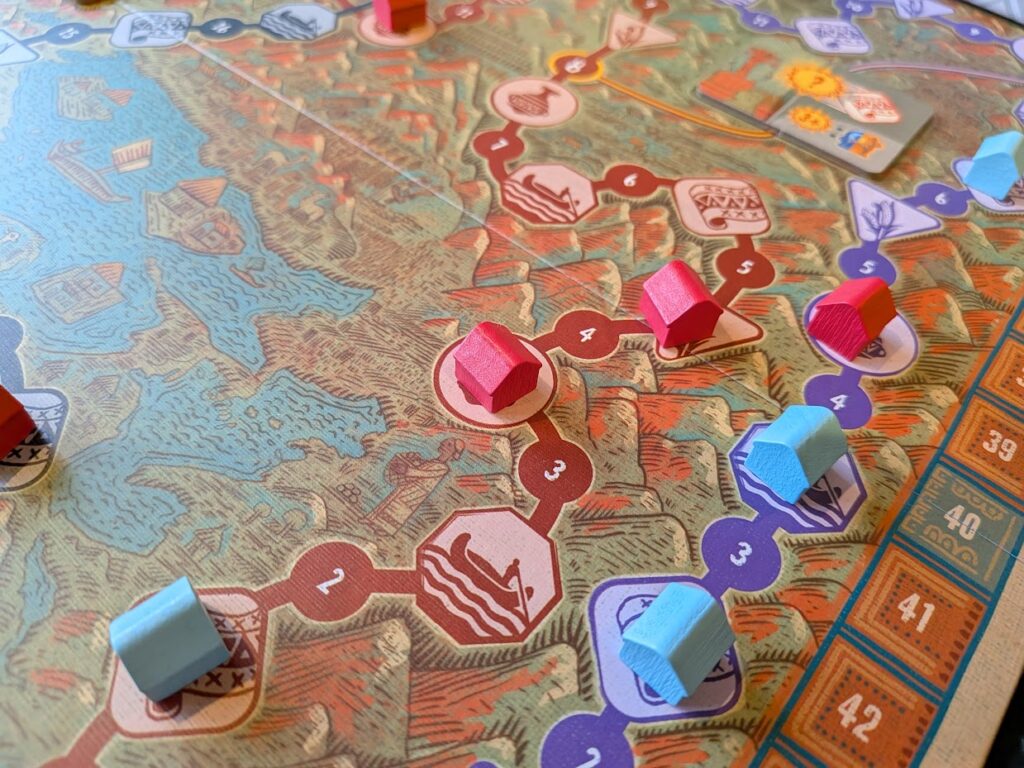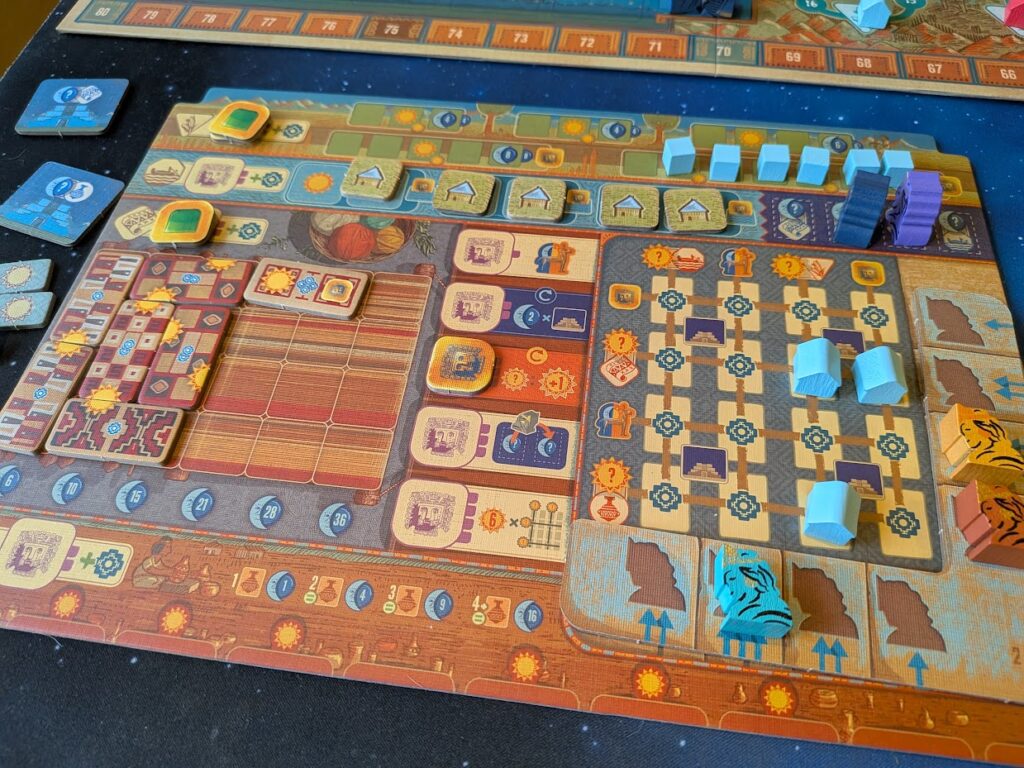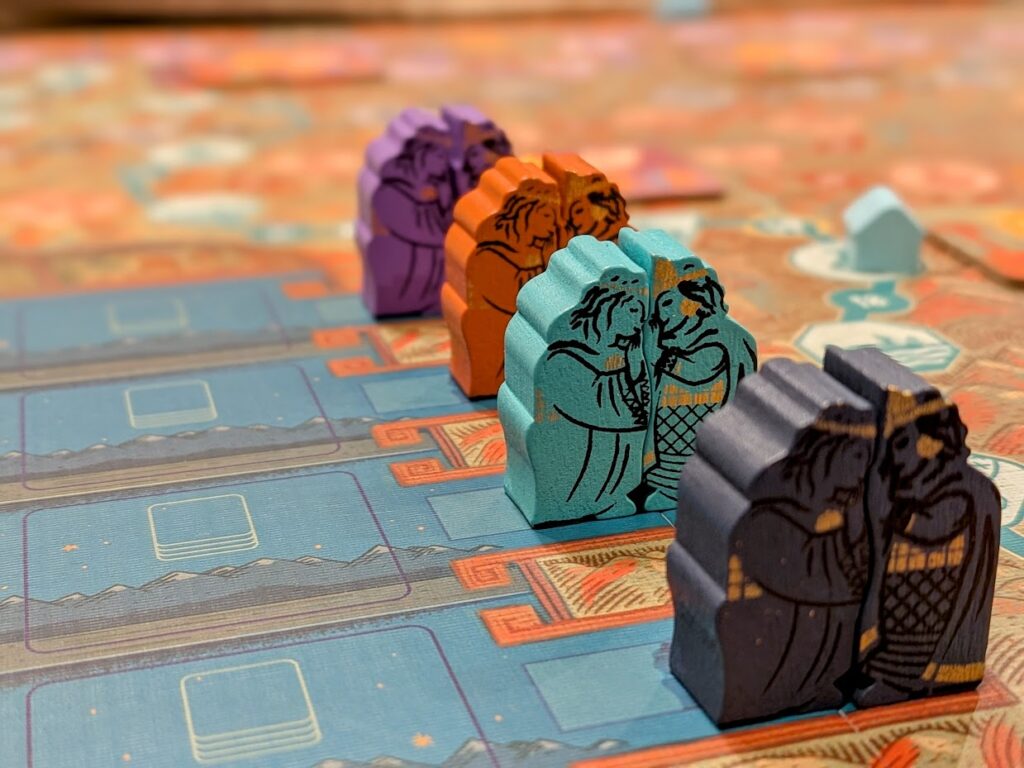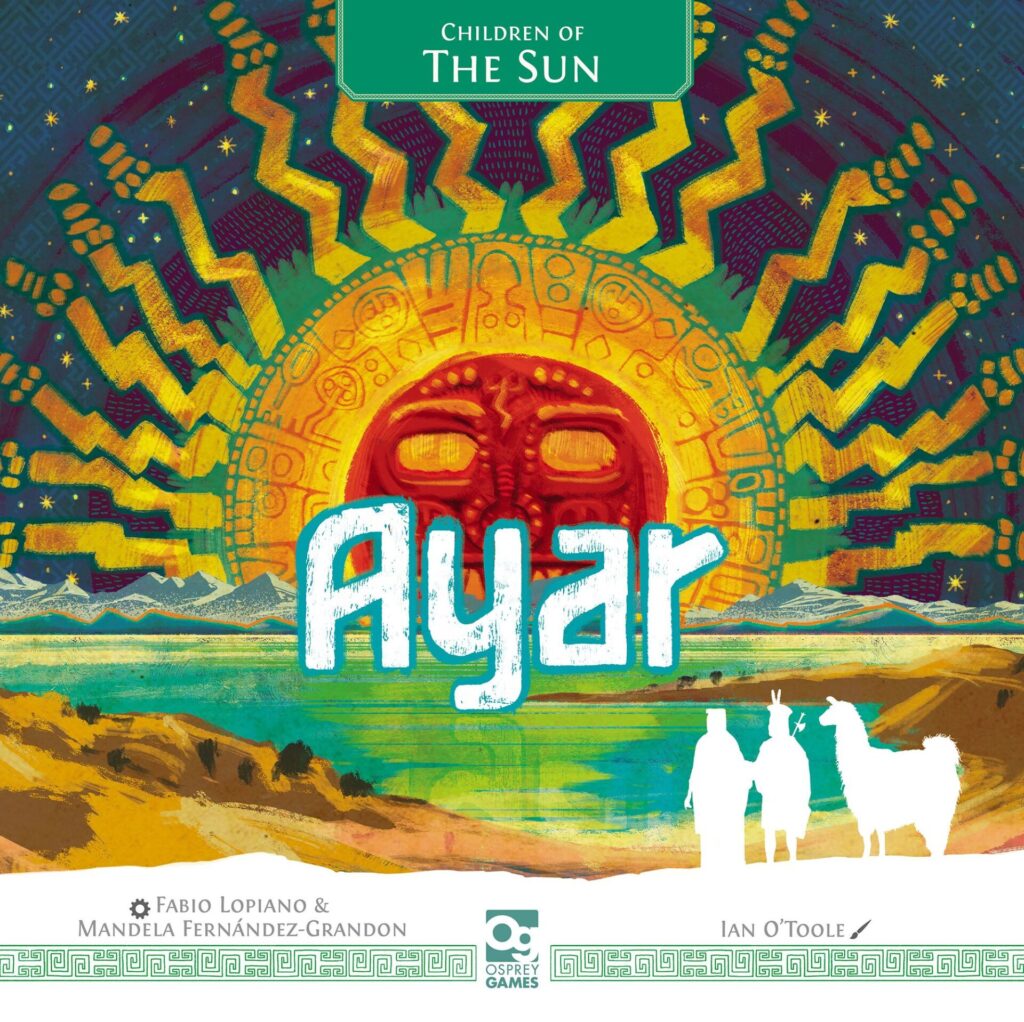If the style and colours on the Ayar box look familiar, that’s because they are. We’re looking at the next game from Osprey Games featuring the dynamic duo of Fabio Lopiano pushing buttons and pulling levers (i.e. game design) and Ian O’Toole daubing everything with colour in his own style. Mandela F-G is co-credited with the design, and the games you might be thinking of when you look at it are Merv and Sankoré, reviews of which you can read here and here, respectively. Ayar does things differently from its predecessors, but still retains the feel and atmosphere of them while offering something wholly different. I think it might be the best of the bunch.

The story behind Ayar is, like many Euro games, something you’ll immediately forget or ignore. The original Incan creator brought forth Sun and Moon gods, which in turn begat four pairs of siblings. These siblings travelled the Earth until only two remained, who then founded the Incan empire. You won’t remember or feel any of this while you play the game, but it doesn’t matter. We’re Eurogamers, right? Theme is consequential, not essential.
Trailblazers
Ayar is, like those aforementioned games that came before it, a collection of four mini-games, combined into one larger one. If you use Sankoré as a comparator, Ayar is much simpler. The agricultural action, for example, it simply lifting cubes from your player board and dumping them on the side board. Tapestry actions involve taking little 2×1 tapestry tiles and arranging them on your player board, trying to fill columns and get little half sun icons to match up. The pottery action lets you take tiles from the market in an effort to make matching coloured sets. The most difficult action is the boat action which lets you spend action points to traverse a point-to-point map, dropping little building tiles off along the way.

The number of action points you have for each of the game’s fifteen turns determines how strongly you can perform each action. Buying better, or more numerous tapestries or pots. Dropping more agriculture cubes from your board, or moving more spaces along the boat board. The game’s hook comes from how you earn these action points.
You choose one of the columns or rows on your board and place once of the coloured step markers on it. You take a little house (or Tambo, to use the game’s parlance) from that row and place it on the action spot you want to take, and the number of now-empty spaces on the row or column is the strength of your action. Take the fourth building off, you get four points to spend. Pretty easy, right?

The difficulty, as it were, is in choosing which step marker to place. Each matches the colour of one of the Ayar figures on the main board, which in turn are stood on a numbered spot on a meandering path across the board. Between each numbered spot is an action space bearing the icon for one of the four game actions. You move the Ayar the number of spaces indicated on your board, then plonk your house on any of the spaces behind the Ayar. This is where things start to get complicated, because if you’re trying to do the same actions as the other players, your choices can get quite limited, quite quickly.
You snooze, you lose
You might think that with four Ayar figures moving along four tracks, there’s never going to be a fight for the type of action space you want. Ayar turns this on its head by retiring the furthest back figure at the end of each round. That last placed Ayar triggers some temple scoring, but from that point on there are only three tracks with action spots, and you lose the matching step marker at the same time. So while the first round of the game sees you taking five actions on the four different tracks (you have a gold piece which is wild), the subsequent rounds see you taking four actions, then three, and in the final round you only get two. Granted, these actions get stronger, but it’s an interesting puzzle to wrap your head around.

Scoring is a strange beast in Ayar. It has the feel of a Reiner Knizia game, because you constantly try to balance two scoring markers. At the end of the game, the smaller of the two – sun or moon points – is your final score. What makes it really interesting to me is the way these two scoring tracks differ.
Moon points trigger in batches throughout the game. Whenever you score them, either by temple tiles being triggered by retiring Ayars, or retiring step markers on your board, you usually get a nice big dump of points at a time. Sun scoring is a different creature. You have a score dial which you add points to whenever sun scoring is triggered, which isn’t too often, but points never come off the dial. It’s cumulative, so every time you trigger it you get more points than the last time.
It means that heading into the final round it can look like your sun points might only just break 20, while you’ve already crested 100 moon points. But those last few activations of the sun dial can do some real heavy lifting.
Eggs in baskets
As is true in many modern games, Ayar is pretty open-ended when it comes to choosing a strategy. You can go steaming in on one or two actions, going for a real min-max approach, or, if you prefer not having all your eggs in one basket, you can slowly chip away at all four and make a more considered approach. The difficulty comes with future planning and predicting the way the game is going to go.

To be accurate, it’s actually about predicting and influencing the future of the game. There are only a few opportunities to trigger sun scoring during the game, and more than 50% of them can come from the main board. There are sun tiles randomly distributed along the paths the Ayars take, and when they get as far as a tile, that particular sun scoring is triggered for everyone.
As I mentioned above, though, an Ayar leaves the board at the end of each round. You know what that means – no Ayar on a path, no sun score triggering. So much of playing the game – at least, playing the game well – lives in this part of the design. You can see right from the start of the game which Ayars will trigger which sun tiles, and you have a limited, shared ability to determine which Ayar will kick the bucket in each round. If you go headlong into one particular action right from turn one, it can reap some pretty hefty dividends later in the game, but only if you can keep the Ayars you need on the board.
It’s a wobbly walk along a very bouncy tightrope, and it’s a puzzle I really enjoy trying to solve.
Final thoughts
I make no secret of the fact that I like Fabio Lopiano’s games. Even though I thought they used to end too soon (Merv, Zapotec), and even though this series of games through Osprey all seem to be a collection of four minigames. Merv was great, but very tight. Sankoré was also really good, but heavy and difficult to understand the scoring mechanism, which I found left some new players confused and less-than-enthused to play again. Ayar, in contrast, seems to have found the sweet spot.
There’s a lot to like here. First and foremost, it’s quick. I’ve taught and played it with three and four players, and even then the teach and game last no more than two hours. It feels refreshing when most of the games I play these days tend to fill three hours. Despite its relative brevity, it still feels like a chunky game with a big, beige sandbox to play in. Every time I play it, I try something different. Granted, most times I usually lose, but I like the fact I can experiment while staying competitive, and know that it’ll be days instead of months before I play it again.
I’m not a fan of overproduction in games, but in Ayar’s case, I think it really could have done with double-layer player boards. All of the wooden pieces sit on a flat piece of card, and should you bump the table, if they end up in the wrong place, it can drastically affect the state of your game. The solo mode is a pleasure to play. It’s quick and easy to run, and a great way to practise, but Ayar is really at its best with three or four players.
If you’re looking for a middle-weight Euro with a lot of scope for experimenting, player-driven game states, and a really interesting set of diminishing actions, Ayar is worth a look, and the best of the three in the series.
You can buy Ayar right now from my retail partner, Kienda. Head over to this page to get more details and even get a 5% discount on your first order.
Enjoying this article? Consider supporting me.

Ayar: Children of the Sun (2025)
Design: Fabio Lopiano, Mandela Fernandez-Grandon
Publisher: Osprey Games
Art: Ian O’Toole
Players: 1-4
Playing time: 60-90 mins


